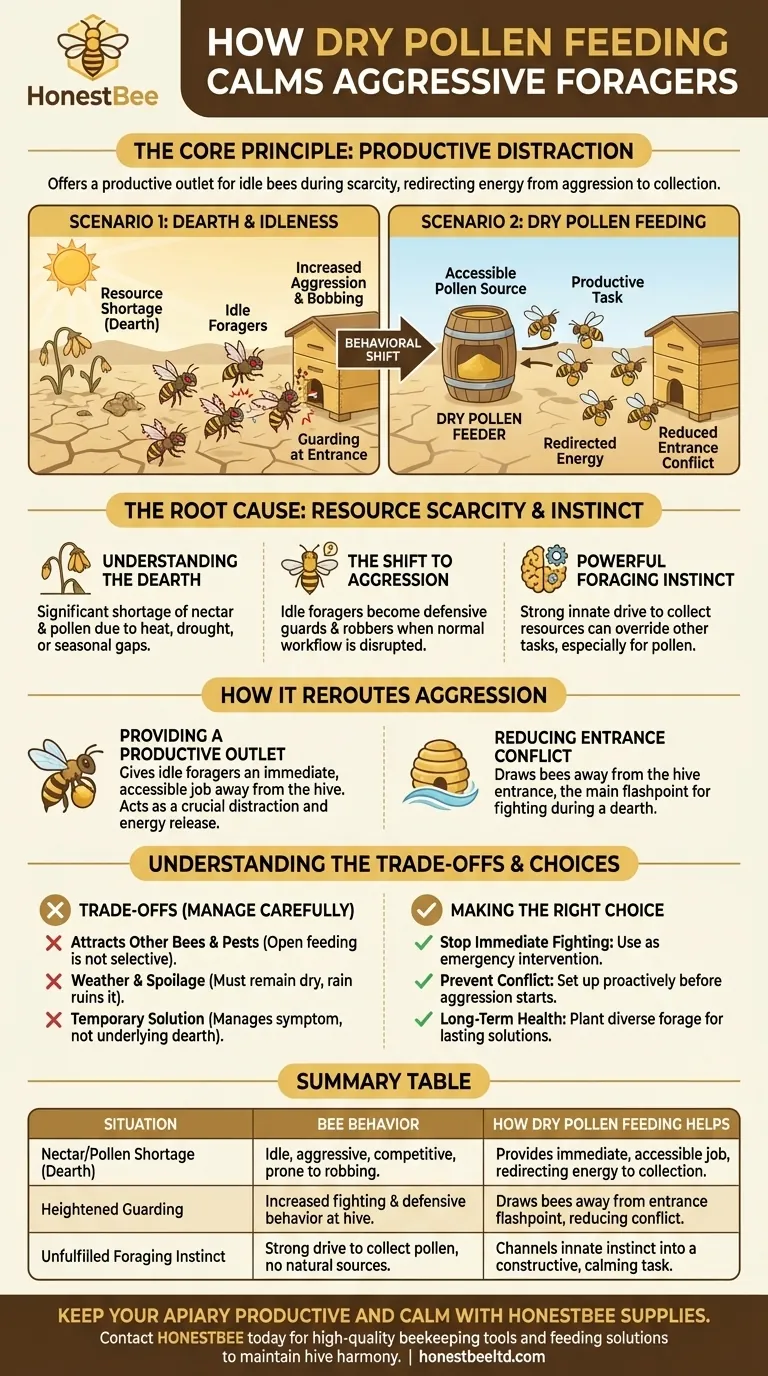At its core, dry pollen feeding reduces forager aggression by providing a productive distraction. During a nectar or pollen shortage, idle foragers become competitive and prone to fighting. By offering an accessible pollen source away from the hive entrance, you give these bees a job to do, redirecting their energy from guarding and robbing to the more constructive task of collection.
When natural forage is scarce, a bee's powerful instinct to work can turn into aggression toward other bees. Providing a dry pollen source channels this instinct back into productive collection, calming the colony by giving idle foragers a mission.

The Root Cause: Resource Scarcity and Bee Behavior
Understanding the "Dearth"
A dearth is a period when there is a significant shortage of nectar and pollen-producing flowers. This can happen due to high summer heat, drought, or seasonal gaps between major blooms.
Without incoming resources, the colony's normal workflow is disrupted.
The Shift to Aggression
Bees are hardwired to forage and work for the colony. When there are no flowers to visit, thousands of foragers become unemployed and idle.
This idleness often manifests as heightened defensive behavior. Bees become more aggressive guards at the hive entrance and may begin robbing weaker hives for their resources, leading to intense fighting.
The Powerful Foraging Instinct
A honey bee colony has an incredibly strong, innate drive to collect resources, especially pollen, which is essential for raising brood.
This instinct is so powerful that if their pollen collection is hindered, colonies will actively convert nectar foragers into pollen foragers to compensate. This shows that the drive to collect pollen can override other tasks.
How Dry Pollen Feeding Reroutes Aggression
Providing a Productive Outlet
Dry pollen feeding is less about nutrition and more about behavioral management. It provides an immediate and accessible job for the army of idle foragers.
Instead of fighting at the hive entrance or seeking out hives to rob, they have a valuable task to focus on. This acts as a crucial distraction and a release valve for their pent-up energy.
Reducing Entrance Conflict
Much of the aggression and fighting during a dearth occurs at the hive entrance as guards fend off robbers from other colonies.
By placing a pollen feeder some distance away from the hives, you draw the bees away from this flashpoint. They become busy collecting the substitute pollen, which significantly reduces the likelihood of them fighting with each other.
Understanding the Trade-offs
Attracting Other Bees and Pests
Open feeding is not selective. Your pollen feeder will attract bees from every colony in the area, not just your own.
It can also attract other insects and pests, so placement and maintenance are key to minimizing unintended consequences.
Weather and Spoilage
Dry pollen must remain dry. Rain or even heavy dew can cause it to spoil, clump, and become useless to the bees.
You must place the feeder in a sheltered location and monitor it to ensure the contents remain fresh and accessible.
A Temporary Solution, Not a Cure
It is critical to recognize that open feeding manages a symptom—forager aggression—but does not solve the underlying problem, which is a lack of natural forage.
It is an intervention tool, not a long-term strategy for colony nutrition or environmental support.
Making the Right Choice for Your Apiary
The decision to use dry pollen feeding should be based on a clear observation of bee behavior and environmental conditions.
- If your primary focus is stopping immediate, intense fighting: Use dry pollen feeding as an emergency intervention to de-escalate aggression and give the bees a non-violent task.
- If your primary focus is preventing conflict during a known dearth: Proactively set up a feeder before aggression starts to keep forager bees occupied from the outset.
- If your primary focus is long-term colony health: The best strategy is to plant a diverse and sequential variety of forage to reduce the severity of natural dearth periods.
Ultimately, managing a calm hive means understanding and working with the powerful instincts that drive your bees.
Summary Table:
| Situation | Bee Behavior | How Dry Pollen Feeding Helps |
|---|---|---|
| Nectar/Pollen Shortage (Dearth) | Idle foragers become aggressive, competitive, and prone to robbing. | Provides an immediate, accessible job, redirecting energy from fighting to collection. |
| Heightened Guarding at Hive Entrance | Increased fighting and defensive behavior at the hive. | Draws bees away from the entrance flashpoint, reducing conflict. |
| Powerful, Unfulfilled Foraging Instinct | Strong drive to collect pollen with no natural sources available. | Channels the innate collection instinct into a constructive, calming task. |
Keep your apiary productive and your colonies calm with the right supplies from HONESTBEE.
Aggressive foragers can disrupt your entire operation. We supply commercial apiaries and beekeeping equipment distributors with the high-quality tools needed for effective hive management, including reliable feeding solutions.
Let us help you maintain harmony in your hives. Contact HONESTBEE today to discuss your wholesale needs and ensure your bees have the resources they require.
Visual Guide

Related Products
- Rapid Bee Feeder White Plastic 2L Round Top Feeder for 8 or 10-Frame Bee Hives
- Professional Dual-End Stainless Steel Hive Tool for Beekeeping
- HONESTBEE Advanced Ergonomic Stainless Steel Hive Tool for Beekeeping
- High Quality Honey Dehumidifier Dryer Thickening Machine for Beekeeping
- No Grafting Queen Rearing Kit: System for Royal Jelly Production and Queen Rearing
People Also Ask
- Do beekeepers leave honey for bees? The Essential Guide to Sustainable Hive Management
- Can sugar syrup contaminate the honey crop? A Beekeeper's Guide to Protecting Honey Purity
- What is the advice regarding feeding bees to limit brood production based on? Managing Prolific Bee Strains
- What is the capacity of the round hive top feeder for syrup and pollen? A Guide to Targeted Apiary Support
- Can you dilute honey and feed it to the bees? Understand the Critical Risks and Safe Practices



















